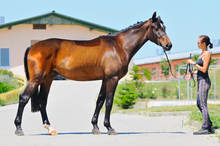The Masterson Method secret to releasing muscle tension is by using a level of touch that bypasses the horsesâ flight or bracing response and allows him to release the tension himself.

Recognizing and using responses of the horse to release accumulated tension
The Masterson Method secret to releasing muscle tension is by using a level of touch that bypasses the horsesâ flight or bracing response and allows him to release the tension himself.
Starting with âair gapâ, a level of touch that barely touches the skin, we can activate the horseâs nervous system to release large amounts of muscle tension. Using a simple axiom: Search, Response, Stay, Release, you can begin to facilitate the process.
The Bladder Meridian Technique:
SEARCH â starting at the poll, slowly run your fingers about two inches below the top line of the horse using very light âair gapâ level of touch. Keep the pace slow enough to watch for responses, but not too slow to lose the interest of your horse.
RESPONSE - watch for very subtle signs (for example an eye blink, or lip twitch) where the horse tells you there is tension being held under that area. Once you see the horse respondingâ¦.
STAY - remain very lightly on that area, doing nothing, except bringing the horseâs attention to the area, so that his nervous system can start the next stepâ¦.
RELEASE - the horse begins to give larger signs that muscle tension has let go. These larger release responses can be one or a combination of the following: licking and chewing, snorting or sneezing, shaking its head or body, or repeated yawning.
With this Search, Response, Stay, Release process the horse will show where his muscles have accumulated tension, and when that tension is being released. Although this formula can be used anywhere on the horse, the Bladder Meridian starts at the poll and runs about two inches off of the crest of the horse until it reaches the croup. From there it leaves the top line and follows the groove down the hind leg, over the side of the hock, just off the hind centerline of the leg, down the groove of the cannon bone, over the fetlock to its termination on the coronary band.
We know from experience that after the horse has shown these release responses there is more relaxation and circulation in the muscles. Range of motion is improved and often straightness is enhanced as unilateral tension or âtorqueâ on the key junctions has released. You should feel the difference in the ride and, if youâre competing in a timed sport, a difference in the clock.
By taking the time to really focus on the horseâs responses, and having the patience to lightly wait (STAY, STAY, STAY) until the horse gives you a larger release, you will obtain amazing results.
Throw away the clock; youâre on the horseâs time now. It can take up to a minute or more after the smaller initial response on an area for the horseâs nervous system to start to let go. Stay focused on what the horse is âtellingâ you during the process. He is the leader in this dance between the two of you.
When your horse RELEASES, itâs like hitting gold. When he begins to lick and chew, or yawns repeatedly, there can be no doubt of a correlation between your light touch and the horseâs release of tension.
This technique is deceptively simple, but incredibly powerful.
To watch Jim teaching the Bladder Meridian technique at a Beyond Horse Massage Weekend Seminar-Workshop visit: https://youtu.be/GPVyG37Wve0
About the Masterson Method® of Integrated Equine Performance Bodywork:
The Masterson Method is an integrated, multi-modality method of equine massage. It is a unique, interactive method of equine massage in which you learn to recognize and use the responses of the horse to your touch to find and release accumulated tension in key junctions of the body that most affect performance.
In contrast to most traditional modalities, it enables the horse to actively participate in the process of releasing tension. It is something you do with the horse, rather than to the horse. This participation and interaction is what makes the method fascinating for those who use it. In fact, if you do not allow the horse to participate, it does not work!
To find out more about the Masterson Method® techniques, books and seminars leading to certification go to: https://mastersonmethod.com/masterson-method
